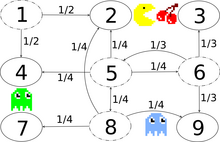Continuous-time Markov chain
This article includes a list of references, related reading or external links, but its sources remain unclear because it lacks inline citations. (August 2020) |
A continuous-time Markov chain (CTMC) is a continuous stochastic process in which, for each state, the process will change state according to an exponential random variable and then move to a different state as specified by the probabilities of a stochastic matrix. An equivalent formulation describes the process as changing state according to the least value of a set of exponential random variables, one for each possible state it can move to, with the parameters determined by the current state.
An example of a CTMC with three states is as follows: the process makes a transition after the amount of time specified by the holding time—an exponential random variable , where i is its current state. Each random variable is independent and such that , and . When a transition is to be made, the process moves according to the jump chain, a discrete-time Markov chain with stochastic matrix:
Equivalently, by the theory of competing exponentials, this CTMC changes state from state i according to the minimum of two random variables, which are independent and such that for where the parameters are given by the Q-matrix
Each non-diagonal value can be computed as the product of the original state's holding time with the probability from the jump chain of moving to the given state. The diagonal values are chosen so that each row sums to 0.
A CTMC satisfies the Markov property, that its behavior depends only on its current state and not on its past behavior, due to the memorylessness of the exponential distribution and of discrete-time Markov chains.
Definition[]
A continuous-time Markov chain (Xt)t ≥ 0 is defined by:[1]
- a finite or countable state space S;
- a transition rate matrix Q with dimensions equal to that of S; and
- an initial state such that , or a probability distribution for this first state.
For i ≠ j, the elements qij are non-negative and describe the rate of the process transitions from state i to state j. The elements qii could be chosen to be zero, but for mathematical convenience a common convention is to choose them such that each row of sums to zero, that is:
Note how this differs from the definition of transition matrix for discrete Markov chains, where the row sums are all equal to one.
There are three other definitions of the process, equivalent to the one above.[2]
Transition probability definition[]
Another common way to define continuous-time Markov chains is to, instead of the transition rate matrix , use the following:[1]
- , for , representing the decay rate (of an exponential distribution) that the system stays in state once it enters it; and
- , for , representing the probability that the system goes to state , given that it is currently leaving state .
Naturally, must be zero for all .
The values and are closely related to the transition rate matrix , by the formulas:
Consider an ordered sequence of time instants and the states recorded at these times , then it holds that:
- [dubious ]
where the pij is the solution of the forward equation (a first-order differential equation):
with initial condition P(0) being the identity matrix.
Infinitesimal definition[]

Let be the random variable describing the state of the process at time t, and assume the process is in a state i at time t. By definition of the continuous-time Markov chain, is independent of values prior to instant ; that is, it is independent of . With that in mind, for all , for all and for small values of , the following holds:
- ,
where is the Kronecker delta and the little-o notation has been employed.
The above equation shows that can be seen as measuring how quickly the transition from to happens for , and how quickly the transition away from happens for .
Jump chain/holding time definition[]
Define a discrete-time Markov chain Yn to describe the nth jump of the process and variables S1, S2, S3, ... to describe holding times in each of the states where Si follows the exponential distribution with rate parameter −qYiYi.
Properties[]
Communicating classes[]
Communicating classes, transience, recurrence and positive and null recurrence are defined identically as for discrete-time Markov chains.
Transient behaviour[]
Write P(t) for the matrix with entries pij = P(Xt = j | X0 = i). Then the matrix P(t) satisfies the forward equation, a first-order differential equation
where the prime denotes differentiation with respect to t. The solution to this equation is given by a matrix exponential
In a simple case such as a CTMC on the state space {1,2}. The general Q matrix for such a process is the following 2 × 2 matrix with α,β > 0
The above relation for forward matrix can be solved explicitly in this case to give
However, direct solutions are complicated to compute for larger matrices. The fact that Q is the generator for a semigroup of matrices
is used.
Stationary distribution[]
The stationary distribution for an irreducible recurrent CTMC is the probability distribution to which the process converges for large values of t. Observe that for the two-state process considered earlier with P(t) given by
as t → ∞ the distribution tends to
Observe that each row has the same distribution as this does not depend on starting state. The row vector π may be found by solving[3]
with the additional constraint that
Example 1[]

The image to the right describes a continuous-time Markov chain with state-space {Bull market, Bear market, Stagnant market} and transition rate matrix
The stationary distribution of this chain can be found by solving , subject to the constraint that elements must sum to 1 to obtain
Example 2[]

The image to the right describes a discrete-time Markov chain modeling Pac-Man with state-space {1,2,3,4,5,6,7,8,9}. The player controls Pac-Man through a maze, eating pac-dots. Meanwhile, he is being hunted by ghosts. For convenience, the maze shall be a small 3x3-grid and the monsters move randomly in horizontal and vertical directions. A secret passageway between states 2 and 8 can be used in both directions. Entries with probability zero are removed in the following transition rate matrix:
This Markov chain is irreducible, because the ghosts can fly from every state to every state in a finite amount of time. Due to the secret passageway, the Markov chain is also aperiodic, because the monsters can move from any state to any state both in an even and in an uneven number of state transitions. Therefore, a unique stationary distribution exists and can be found by solving , subject to the constraint that elements must sum to 1. The solution of this linear equation subject to the constraint is The central state and the border states 2 and 8 of the adjacent secret passageway are visited most and the corner states are visited least.
Time reversal[]
For a CTMC Xt, the time-reversed process is defined to be . By Kelly's lemma this process has the same stationary distribution as the forward process.
A chain is said to be reversible if the reversed process is the same as the forward process. Kolmogorov's criterion states that the necessary and sufficient condition for a process to be reversible is that the product of transition rates around a closed loop must be the same in both directions.
Embedded Markov chain[]
One method of finding the stationary probability distribution, π, of an ergodic continuous-time Markov chain, Q, is by first finding its embedded Markov chain (EMC). Strictly speaking, the EMC is a regular discrete-time Markov chain, sometimes referred to as a jump process. Each element of the one-step transition probability matrix of the EMC, S, is denoted by sij, and represents the conditional probability of transitioning from state i into state j. These conditional probabilities may be found by
From this, S may be written as
where I is the identity matrix and diag(Q) is the diagonal matrix formed by selecting the main diagonal from the matrix Q and setting all other elements to zero.
To find the stationary probability distribution vector, we must next find such that
with being a row vector, such that all elements in are greater than 0 and = 1. From this, π may be found as
(S may be periodic, even if Q is not. Once π is found, it must be normalized to a unit vector.)
Another discrete-time process that may be derived from a continuous-time Markov chain is a δ-skeleton—the (discrete-time) Markov chain formed by observing X(t) at intervals of δ units of time. The random variables X(0), X(δ), X(2δ), ... give the sequence of states visited by the δ-skeleton.
See also[]
Notes[]
- ^ a b Ross, S.M. (2010). Introduction to Probability Models (10 ed.). Elsevier. ISBN 978-0-12-375686-2.
- ^ Norris, J. R. (1997). "Continuous-time Markov chains I". Markov Chains. pp. 60–107. doi:10.1017/CBO9780511810633.004. ISBN 9780511810633.
- ^ Norris, J. R. (1997). "Continuous-time Markov chains II". Markov Chains. pp. 108–127. doi:10.1017/CBO9780511810633.005. ISBN 9780511810633.
References[]
- A. A. Markov (1971). "Extension of the limit theorems of probability theory to a sum of variables connected in a chain". reprinted in Appendix B of: R. Howard. Dynamic Probabilistic Systems, volume 1: Markov Chains. John Wiley and Sons.
- Markov, A. A. (2006). Translated by Link, David. "An Example of Statistical Investigation of the Text Eugene Onegin Concerning the Connection of Samples in Chains". Science in Context. 19 (4): 591–600. doi:10.1017/s0269889706001074.
- Leo Breiman (1992) [1968] Probability. Original edition published by Addison-Wesley; reprinted by Society for Industrial and Applied Mathematics ISBN 0-89871-296-3. (See Chapter 7)
- J. L. Doob (1953) Stochastic Processes. New York: John Wiley and Sons ISBN 0-471-52369-0.
- S. P. Meyn and R. L. Tweedie (1993) Markov Chains and Stochastic Stability. London: Springer-Verlag ISBN 0-387-19832-6. online: MCSS . Second edition to appear, Cambridge University Press, 2009.
- Kemeny, John G.; Hazleton Mirkil; J. Laurie Snell; Gerald L. Thompson (1959). Finite Mathematical Structures (1st ed.). Englewood Cliffs, NJ: Prentice-Hall, Inc. Library of Congress Card Catalog Number 59-12841. Classical text. cf Chapter 6 Finite Markov Chains pp. 384ff.
- John G. Kemeny & J. Laurie Snell (1960) Finite Markov Chains, D. van Nostrand Company ISBN 0-442-04328-7
- E. Nummelin. "General irreducible Markov chains and non-negative operators". Cambridge University Press, 1984, 2004. ISBN 0-521-60494-X
- Seneta, E. Non-negative matrices and Markov chains. 2nd rev. ed., 1981, XVI, 288 p., Softcover Springer Series in Statistics. (Originally published by Allen & Unwin Ltd., London, 1973) ISBN 978-0-387-29765-1
- Markov processes























































